THE LONDON SYMPHONY ORCHESTRA: A MODERN COMPOSER
Following upon a vocally oriented accessible album "You are what you is" (1981), Zappa concentrated on his further establishment
as a composer of modern music for the coming albums. After the "200 motels" recordings he had repeatedly tried to get
some more performances of his orchestral scores. Most attempts failed for all kinds of reasons, except
for the "Orchestral favourites" sessions (recorded in 1975, released in 1979). In "The real Frank Zappa book" he's using several pages
to utter his frustrations about unfulfilled agreements. In 1982 however Zappa had enough means
to hire the London Symphony Orchestra (L.S.O.) and Pierre Boulez commissioned him to compose a piece for the Ensemble Intercontemporain.
The L.S.O. was given a large program of one and a half hour of music, which was originally released in two volumes.
The first one of 1983 having new compositions, the second one of 1987 mostly containing large orchestra versions
of music stemming from "200 motels" and "Orchestral favourites". With the Ensemble Intercontemporain three pieces
of music were recorded, that together with computer performed music were released as "The perfect stranger" in 1984.
Most of the new compositions show Zappa's atonal side full blown.
Zappa's music in general is not accessible, often sounding as loose ends when hearing it for the first time. The appreciation of his
music is a matter of time and getting accustomed to his rhythmic and harmonic versatility. For the majority of CD buyers, who look for music
for direct consumption, his name is familiar, but what he stands for remains obscure and inunderstandable. Inaccessibility applies most of
all to atonal music, when you lose all technical grip of music you're acquainted with. The better atonal music starts to work when, after
listening more frequently, you start recognizing the structure building elements in it and the composition comes alive.
Most of Zappa's atonal music has this effect, in some cases it's more experimental. His atonal music is of the free kind; apart from some
early stuff, he doesn't apply preconceived things as serialism.
The current CD release is carries the title "London Symphony Orchestra, Vol. I & II" in full. The material was released on two separate vinyl albums
in the eighties, with two individual album numbers in the official Zappa catalogue:
Volume I (1983), release nr. #38: Sad Jane, Pedro's dowry, Envelopes and Mo 'n Herbs vacation.
Volume II (1987), release nr. #48: Bogus Pomp, Bob in Dacron and Strictly genteel.
1.1-2. Bob in Dacron
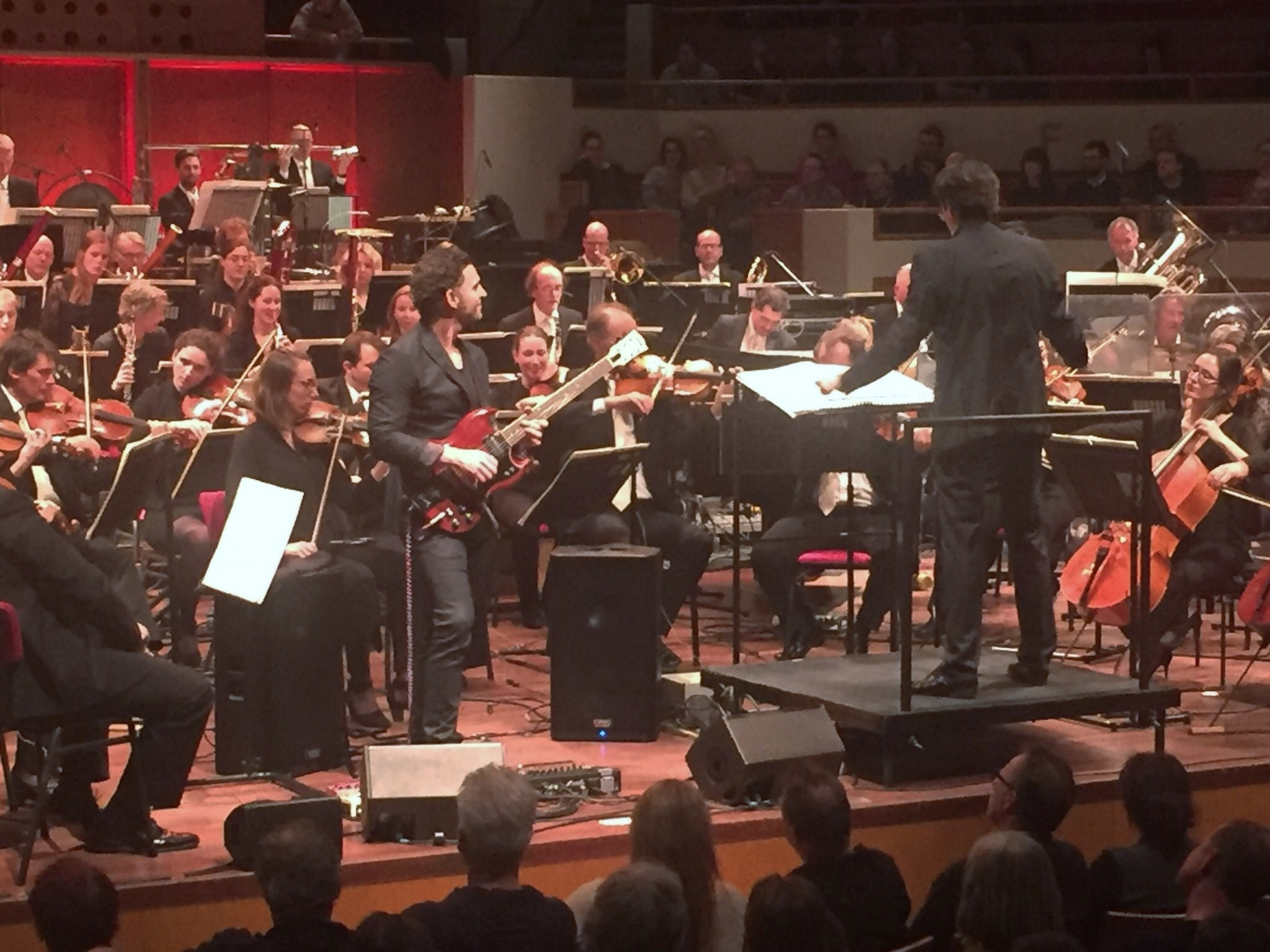 The friendliest new piece recorded with the L.S.O. is probably "Sad Jane". Though not a regular tonal work, there can be
diatonic material recognized in it. Possibly for this reason Zappa used it as the album opener on volume I. It was
written, however, as part II of a two-part ballet with "Bob in Dacron" as part I. On the CD release volumes I and II are
mingled and re-ordered. Now "Bob in Dacron" and "Sad Jane" are coupled as originally intended.
The friendliest new piece recorded with the L.S.O. is probably "Sad Jane". Though not a regular tonal work, there can be
diatonic material recognized in it. Possibly for this reason Zappa used it as the album opener on volume I. It was
written, however, as part II of a two-part ballet with "Bob in Dacron" as part I. On the CD release volumes I and II are
mingled and re-ordered. Now "Bob in Dacron" and "Sad Jane" are coupled as originally intended.
Dweezil Zappa performing with the Noord Nederlands Orkest (Northern Dutch Orchestra), 12-1-2017, at Tivoli-Vredenburg, Utrecht. Next to works
by Dweezil and Steve Vai, the orchestra performed "Bob in Dacron", "Sad Jane" and "Strictly genteel" as on "The L.S.O." (photo tweeted by "LeQuWeet").
In 2012 a dissertation by Vu Nguyen appeared, with a few bars from "Bob
in Dacron" and quite a lot of examples from "Sad Jane" in it. See the literature list for the details.
Bob in Dacron, section (midi file).
Bob in Dacron, section (transcription).
Bars from Bob in Dacron and Sad Jane, lead melody (score).
The example above contains bars 243-259 from "Bob in Dacron". It corresponds with 4:21-5:04 from movement II on the "L.S.O." CD. It's a good example to look at
for noticing the many ways Zappa is structuring his music, combined with an ongoing desire for variation. It goes as:
- Bars 243-6. A repeated figure in an odd meter and rhythm. On CD the figure from staff 3 starts at 4:11. This figure
gets accompanied by a series of other figures. Bars 243-6 are the last one from this series, including a little
counterpoint movement in staff 4. The whole is atonal.
- Bars 247-8. For the remainder of the example you can see the following global pattern: two bars in 3/4 with sustained notes, alternated
with one bar in an odd meter with melody lines. These bars with odd meters are played by the string section only. All other bars are played by wind instruments.
So the instrumentation is used as well as a method to support the alternation. The chord in bars 247-8 is pretty dissonant. It's made up of stacked major sevenths,
as a series G-Gb-F-E.
- Bar 249. A bar in 7/8. Here the music becomes diatonic, but without a clear pedal note/tonic it can't be assigned to a specific key. This goes for
much of "Sad Jane" too. Like Brett Clement below, Vu Nguyen noted examples of rhythmic variations in his Sad Jane dissertation.
Here it concerns the upper descant in staff 1 from the bars with odd meters. This melody line, with a different rhythm, can be found in other
parts of "Bob in Dacron" and "Sad Jane" as well (see the lead melody examples above). As happening more often, there can be differences
between the score and the CD version(s). In this case they are minor. The three repeated B notes get combined to one dotted quarter note. The final
A from bar 249 has either become inaudible or got skipped altogether. Most variations in "Sad Jane" or Zappa's music in general are standard variations, thus
being both melodic and rhythmical variations.
- Bars 250-1. The chord from bars 247-8 returns.
- Bar 252. A bar in 5/4. The music is atonal again. The style is homophonic, all parts are moving in the same direction. Something
Vu Nguyen noted is that Zappa can let the single notes of his melodies go up and down after each other for longer periods. He's using
the term contour interval (INT), that can have the values of + for ascending and - for descending. In this bar it's + - + - + + - + -. Thus apart
from one occasion with two times a subsequent plus happening, the remainder is plus and minus alternating.
- Bars 253-4. Another sustained dissonant chord. Here dynamics are used to give it some more variation: the volume decreases and swells again per bar.
- Bar 255. Another melodic bar in 5/4. Here the writing style has become polyphonic. Apart from the parallel thirds in staff 1, the other two melodies
are following their own directions.
- Bars 256-7. These two bars are alike bars 253-4, but played louder and with the dissonants coming out more sharply.
- Bar 258. The second 7/8 bar in this example. The writing style is mixed. In bars 255 and 258 you can again see that on the CD the repeated eight notes
get joined into a quarter note.
- Bar 259. The final chord of this passage, sustained over a longer period (I let it start in 3/4 again, but can't tell for sure that this is the case in the score).
This ending chord is relatively consonant. The only minor second dissonance combination, F#-G, is taking place over a distance of two octaves, thus not that sharp.
It clearly serves as a resting point. Consonants can really sound extra beautiful in a context like this.
Bob in Dacron, opening (midi file).
Bob in Dacron, opening (transcription).
This last example contains the first four bars from this piece in reduced form. On the CD it can be heard between 0:00 and 0:09.
The notes are played by various instruments with the bottom two staves representing pizzicato notes for the strings.
This instrumentation isn't included in this example, nor in the midi file. Regarding its rhythm it contrasts
sharply with the clarinet part from "Mo 'n Herb's vacation", which is full of irregular rhythmic groupings. Here the orchestra
is using eighth and quarter notes only without any divergence between the parts. It's an atonal chord progression. Except from the final chord from bar four,
there are no sharp dissonances: minor second distances get avoided. The chords contain three up to five notes, also different from the larger chords
with which "Mo 'n Herb's vacation" starts (see below). I may be missing notes here when transcribing it from the CD, but, as shown below,
it also happened frequently that notes from the score got skipped.
1.3-4. Sad Jane
As indicated above, "Sad Jane" is the second movement of a ballet, with "Bob in Dacron" as its first movement. Some bars from "Sad Jane" were already
shown above. The opening bars from "Sad Jane" contain:
- Bars 1-2. The piece opens with the chord C-E-A-B, accompanied by a repeating harp figure in staff 6. The bass pedal A implies
A Dorian.
- Bars 3-4. The bass pedal note switches to G#, thus the scale becomes an A Dorian variant with a major 7th, instead of a standard
diatonic scale. Nguyen calls it "A Dorian with a somewhat ambiguous leading tone". It makes the harmony more dissonant. In bar 6 the opening melody ends
with G natural, thus normal A Dorian.
- Bars 4-6. Melodic material enters the picture. The music is through-composed with ongoing variations upon a series of motifs. The melody
from staffs 5-6 could be called the first motif. As pointed at by Nguyen, the movement in its tail, F#-G#-E-G, with two upward steps followed by a descending step, is the
element that gets varied upon frequently during the first movement of "Sad Jane".
- Bars 7-8. These two bars are composed in a so-called hocketing style. On every eighth tick another instrument plays one or more subsequent notes
with varying durations. Bar 8 can be seen as a variation upon bar 7. The music is now made up of fragmented diatonic material. Beats 1-2 of bars
7-8 could be interpreted as belonging to one set and beats 3-4 as belonging to another set. Which scales can't be said. There is no key note, it's
floating.
- Bars 9-10. Staffs 1-2 contain a variation upon motif 1. Its tail is identical. The other instruments continue to play in a hocketing manner.
- Bar 11. The meter switches to 7/8. The accent switches from the wind to the brass section. Motif 1 turns up in another variation. The variation upon the
tail appears in staff 7 in the shape of E-F-A-D.
- Bar 12. Faintly the tail gets varied upon again. The bells from staff 5 play the three upward notes, after which staves two and three continue with a lower
chord. So far the rhythm has about all been evenly divided over the meters with the eighth note as time unit. For Zappa standards that's uncommon, making the opening
sound quite serene and beautifully orchestrated. The example described below shows more diversity regarding the rhythm aspect.
Sad Jane, opening (midi file).
Sad Jane, section (midi file).
Sad Jane, opening (transcription).
Sad Jane, section (transcription/score).
The second example above is bars 104-112, to be found
a little after the beginning of movement II. With a number of corrections from the score the chords can be identified more clearly, so it can be seen
better that much of "Sad Jane" is diatonic or made up of scale fragments, next to more atonal episodes. The identification of the chords as sus2 and sus4 chords by Nguyen suggest
a diatonic environment. These two chord types are, in case of Zappa, common in his diatonic music. The example goes as:
- Bars 104-5: the chord is Gbsus2 plus F or Db plus Gb. There are not truly tonics operating here. The positioning of the chords give the note, that is played
the lowest, a weak suggestion of being the tonic. In this case the implied scale is Gb, with only once an A natural in the melody turning up as an altered
note within this scale. The notation is done in an atonal manner with enharmonic variants.
- Bars 106-7: the chord is Bbsus4 and the implied scale Bb. This second excerpt from
"Sad Jane" shows a mix of regular and irregular rhythms in a 4/4 meter. The irregularity shows itself in the form of a quintuplet,
but more so in the difficult clarinet-drumset part of bars 112-4.
- Bar 108: the chord is Dsus2. The melody uses C/G and C#/G#, making it impossible to assign this bar to one specific scale.
- Bar 109: the chord is a stacked fifth on Eb, corresponding with the notes from Bbsus4, and the implied scale is Eb Lydian.
- Bar 110: the chord is Dsus4 in the score (on CD I don't manage to hear it's positioning for certain, the fourth A-D is the best audible element).
The implied scale is D or D Mixolydian.
- Bar 111: the chord is a stacked fifth on C, corresponding with the notes from Gsus4, and the implied scale is C Lydian.
- Bars 112-4: here the rhythm becomes the ear-catching factor. The melody is using D and C only. The timpani offer some more pitches and the whole gets atonal.
In case of Zappa it's more a rule than exceptional that CD versions differ from the score (see the Uncle Meat section for an overview). Bar 112 and following
got altered during the L.S.O. recording sessions, probably on the spot. All harmony notes got skipped and the rhythm goes differently. The descant pattern is D-C-D-pause-D-pause. In the score all notes
and the pauses are of equal length, using eight notes as triplets. It's evenly divided over the beats. This is not the case on CD, where the pattern still
exists, but with a much more irregular spreading of the notes over the beats.
The included bars in the dissertation of Nguyen cover:
Bob in Dacron
- Lead melody: bars 234-237, 249-258 and 291-294.
Sad Jane
- Reductions: bars 1-4, 104-116 and 149-152.
- Lead melody: bars 5-23, 35-36, 41-46, 54-64, 66-69, 77-78, 81-85 and 162-167.
- Harmony: bars 94-101.
- Wind ensemble arrangement: bars 27-30, 47-53, 119-121 and 158-160.
1.5-7. Mo and Herb's vacation
Zappa's largest composition in the atonal area is the three part orchestral piece "Mo and Herb's vacation", for which I'm giving a melody that is
repeated and varied upon on different places in the piece. It's an example of a sort of cross-referencing figure on a macro scale
(relationship at great distance), that builds coherence in such compositions.
Mo 'n Herb's vacation, part I, 2:18 till 2:25 (midi file).
Mo 'n Herb's vacation, part III, 1:41 till 1:48 (midi file).
Mo 'n Herb's vacation, part I, 2:18 till 2:25 and part III, 1:41 till 1:48 (transcription).
This melody is introduced by a clarinet in part I (starting at 2:18), where it is accompanied by two other clarinets, mainly playing parallel at varying interval distances. It is repeated by a solo clarinet in part III, starting at 1:41 and by a solo violin at 3:54, playing a fourth higher. On a micro scale motif variation can be detected in this melody in bars 4-7. The motif is here constructed as one starting note in the prior bar, one metric accent note, followed by a three times repeated note. The melodic line of the motif is mostly descending. Variations on this motif section of the melody return quite often:
- Part II, 2:46 till 2:57, 3:19 till 3:32, 3:39 till 3:51, 3:59 till 4:07, 5:03 till 5:04, 6:30 till 6:38, 7:21 till 7:43.
- Part III, 3:11 till 3:25, 11:40 till 12:17.
Two variations are given here beneath. The first is from the second movement. Only the lead melody from this example could be properly
transcribed. You've got violincellos and contrabasses playing around it, but their notes are difficult to discern straight from CD.
The second example stems from the third movement (the accompanying notes in the transcription are left out). It's played slowly at the end
of part III, preceding the coda outburst. In both instances the three times repeating note is replaced by a twice repeating note.
During the first example you can see that the motif is first played with quarter notes, next with eighth notes. Because of the difficulties
in transcribing from CD at this point, I can't do much with this except for noting the motif variations.
Mo 'n Herb's vacation, part II, 3:19-3:34 (midi file)
Mo 'n Herb's vacation, part III, 11:40 till 12:19 (midi file)
Mo 'n Herb's vacation, part II, 3:19-3:34 (approximation).
Mo 'n Herb's vacation, part III, 11:40 till 12:19 (transcription).
During his lifetime Zappa never ceased expressing his admiration for Edgar Varèse, so it might be obvious that
biographers and researchers attempt to compare Zappa's music with the music by Varèse. An essay by Allan Wright can be
downloaded at http://theses.gla.ac.uk/492/01/2007wrightmmus.pdf. This article collects some people's statements about
this matter and further investigates them. His main conclusion on page 65 is that "although it is easy enough to indicate areas of his music that evoke
some of Varèse's sounds, it would be a stretch to conclusively say that Zappa adopted Varèse's techniques of composition".
Next is the opening page of
the "Mo 'n Herb's vacation" score, as reproduced in Allan's essay (pick-up bar and bars 1-2).
Mo 'n Herb's vacation, part I, 0:00 till 0:10 (midi file).
Mo 'n Herb's vacation, part I, 0:00 till 0:10 (score).
It's exemplary of the rhythmic variation and the outspoken
atonal atmosphere to be heard in this composition. About all is chromatic and the chords formed offer a wealth of dissonant
harmonies. In these two bars, the following chords can be heard (bottom up, and ending with the intervals indicated as the number of minor seconds):
- Pick-up bar, beat 1: (C)-C-Db-E-Ab-Bb-Eb-G (chromatic 7-note combination), 1-3-4-2-5-4.
- Pick-up bar, beat 2: (C)-C-E-G-A-Bb-Db-F# (chromatic 7-note combination), 4-3-2-1-3-5.
- Bar 1, beat 1: (D)-D-Eb-Gb-Bb-C-F-A (chromatic 7-note combination), 1-3-4-2-5-4.
(the basic repeated chord, there's also a passing chord involved)
- Bar 1, beat 2: Bb-D-A-E-F-C-G (Bb Lydian scale), 4-7-7-1-7-7.
- Bar 1, beat 3, chord 1: Db-Ab-A-E-B-Eb-F# (Db (C#) Aeolian scale), 7-1-7-7-4-3.
- Bar 1, beat 3, chord 2: F-Bb-C-Db-Ab-Eb-G (F Aeolian scale), 5-2-1-7-7-4.
- Bar 1, beat 4: A-D-F-Gb-Bb-C-E-G (chromatic 8-note combination), 5-3-1-4-2-4-3.
(the melodic movement over beat 4 uses notes from this combination, vertically no new chords are created by this little melody)
- Bar 2, beats 1-2: Eb-G-Bb-C-Db-E-F-A (chromatic 8-note combination), 4-3-2-1-3-1-4.
- Bar 2, beats 3-4: (A-Db-E-F)-Db-E-F-A (chromatic 4-note combination).
For the human ear it's virtually
impossible to identify each note in such a chord without having the score. Most chords are chromatic, but it can also happen
that they can form a (part of a) diatonic scale. Above, on three occasions, the set of notes form a full diatonic scale.
In this case Lydian and Aeolian, when you're taking the lowest bass note as tonic, and then occurring upon different tonics. With that many notes altering,
the overall sound remains chromatic. A different approach is taken by Daniel Schröder in his book Frank Zappa - The composer, pages 74-5.
He puts the notes from the chords above in "alphabetical" order, as if they are scales. He's pointing at the presence of groups of four subsequent notes, tetrachords,
that one might consider to be overlapping with diatonic scales.
Most of the time the dissonant chords are dominating thus persistently that the few spots with consonants are notable, as at 9:27 through 9:38 at the end of movement II.
Clarinet player David Ocker features as the protagonist of "Mo 'n Herbs vacation", most specifically in movement I. Using traditional
terms, this three part work holds the middle between a symphony and a clarinet concert. Movement I is getting some attention in two other
academic studies, the one by Brett Clement (Cl.) and Martin Herraiz (H.). See the left menu for the details. The included bars are:
- Reductions: bars 3-4 (H.).
- Clarinet "lead melody": bars 1-4 (Cl.), 7-8 (H.), 13-14, 25-26,
37-39, 45-48, 56-59, 63-66 and 72-74 (Cl.).
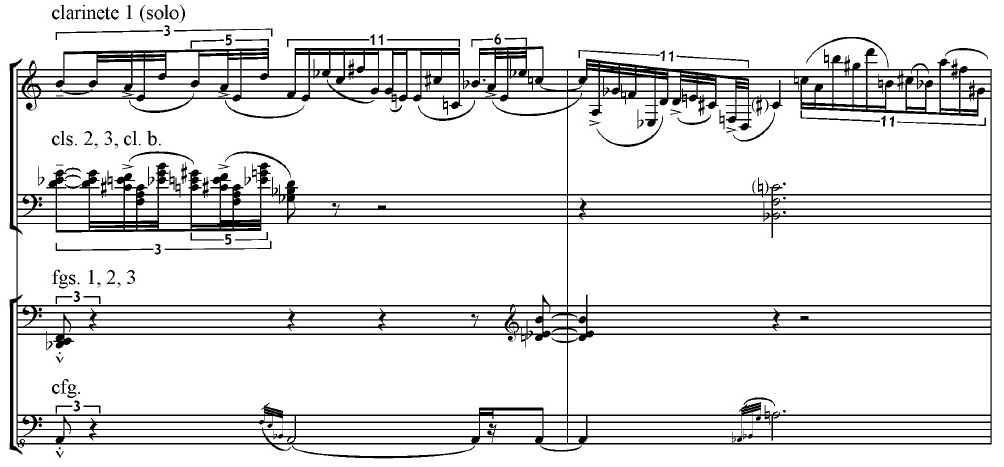
These examples are sufficient to get an idea about the clarinet solo part during the first movement,
being full of irregular rhythmic groupings and odd subdivisions. The image above is bars 3-4 from mvt. I, reduced,
as presented in the Herraiz study (in Portuguese, fgs. (fagotas) stands for bassoons).
It directly follows upon the example from above with bars 1-2.
This sample contains 11-tuplets, as well as a quintuplet within a triplet. The rhythm of all staves, on the other hand, goes synchronous.
See below at "Pedro's dowry", bars 91-92, for a quite different example. Next are bars 25-27:
Mo 'n Herb's vacation, part I, 1:43 till 1:53 (midi file).
Mo 'n Herb's vacation, part I, 1:43 till 1:53 (score/transcription).
Brett Clement's analysis concerns the melodic formation of bar 25, noting:
- Beat two is a transposition of beat one, starting a minor second up.
- Beat three is a vertical mirror movement of this figure.
- The string of notes from bar 25 returns in bar 63, in a different rhythm and transposed up with a tritone.
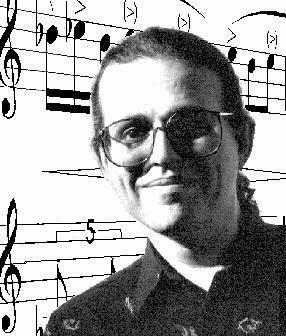 A peculiar phenomena remains that there are always version differences between the scores
and the CD recordings. During beat four of bar 25 the written notes can be heard, but in
a different rhythm. The F has become a grace note, the first two notes last longer than the others
and a G natural got added in. The whole has become an 11-tuplet instead of eight even 32nd notes.
David Ocker plays everything else from this example exactly as prescribed, so this must have been
a conscious move by Ocker and Zappa. Zappa was present during all recordings. To the right a photo of
David from the www.leisureplanetmusic.com site.
In bar 26, as well as bars 1-2 from above, you
can see Zappa's rather dense writing style, here being between homophonic and polyphonic. The staves follow
their own melodic lines. Since their rhythm is the same, the whole also sounds a bit like a series of chords.
You have to listen carefully to recognize the individual melodies.
A peculiar phenomena remains that there are always version differences between the scores
and the CD recordings. During beat four of bar 25 the written notes can be heard, but in
a different rhythm. The F has become a grace note, the first two notes last longer than the others
and a G natural got added in. The whole has become an 11-tuplet instead of eight even 32nd notes.
David Ocker plays everything else from this example exactly as prescribed, so this must have been
a conscious move by Ocker and Zappa. Zappa was present during all recordings. To the right a photo of
David from the www.leisureplanetmusic.com site.
In bar 26, as well as bars 1-2 from above, you
can see Zappa's rather dense writing style, here being between homophonic and polyphonic. The staves follow
their own melodic lines. Since their rhythm is the same, the whole also sounds a bit like a series of chords.
You have to listen carefully to recognize the individual melodies.
Mo 'n Herb's vacation, part I, end (midi file).
Mo 'n Herb's vacation, part I, end (score/transcription).
This last example from mvt. I is its end, to be heard between 4:22 and 4:47. Again a number of differences
between the score and the actual performance can be heard:
- Bar 70: played identically.
- Bar 71: the clarinet line from staff 1 starts on Ab instead of Eb. Rhythmically this bar contains a septuplet
in a shape that also occurs in the preceding bars 57-8 (not included in the midi file), yet another example
of the frequent use of irregular groupings during this movement.
- Bar 72: the ritardando during this bar isn't actually played. The accentuated notes in staff one (clearly audible like
this on the CD) are causing some rhythmic divergence between the parts.
- Bar 73: now the tempo drops at once on the CD and during this bar the ritardando effect is present. Peculiar
is a notational difference between the Bb clarinet score - switching to 3/4 - and this clarinet part from the conductor's score, continuing in 4/4.
Because of the equation (one 16th sixtuplet note becoming one eighth note) it causes no real difference, but it does affect the bar numbering.
When you concentrate on it, you can hear three individual melodic lines during this bar. Their rhythm is identical, so the effect is that it gets to sound
as a chord progression, like in the previous example.
- Bar 74: on the album the last chord of bar 73 gets sustained instead of staff one going over to a higher E (I don't have the other parts from
the original score, so I can't tell if it's just this E that got skipped). Nor does the final bar last a whole note. Considering the ritardando effect
being strong at this point, the final chord gets sustained for about an eighth note in bar 74.
As also pointed at by Brett Clement, the melody from staff one during bars 72-3 forms a sequence. The first sixtuplet figure from bar 72 gets varied upon:
- by transposing it.
- by transposing it and changing the intervals in its tail.
- by horizontally mirroring its type of movement.
Mo's vacation, 0:00-0:21 (midi file).
Mo's vacation, 0:00-0:21 (transcription).
On the internet you can find some information about how "Mo 'n Herb's vacation" came into being. At the request of David Ocker Zappa had written
a clarinet solo. First a bass and drum part got added, next other instruments, till it eventually became mvt. I of "Mo 'n Herb's vacation".
Mvt. II apparently existed earlier as "Wooool", including graphic instructions for the orchestra. After Zappa got informed that earlier
attempts to record orchestra scores with graphics were unsuccesful, he scored out everything in detail in standard notation, adding a third movement to it for the L.S.O.
In 1978 the band had the bass and drum part in its program, to be played seperately under the title "Mo's vacation".
In this shape it can be found on the 2020 ZFT release "Zappa - Original motion picture soundtrack". The example from above contains the first
six bars. Bars 1-2 are readily recognizable as the start of the later mvt. I. Without the clarinet part this goes much less for bars 3-6.
A little outtake of "Mo's vacation" also got included in the interlude from "Fembot in a wet T-shirt". See the corresponding section for
Arthur Barrow's comment upon "Mo's vacation".
Mo 'n Herb's vacation, part II, 0:00 till 0:12 (midi file).
Mo 'n Herb's vacation, part II, 0:00 till 0:12 (score/transcription).

This example above is the opening from the 2nd movement, based upon a sample bar I could find on the net. Once more beat 1 of bar 1
is a brief variation upon the material from the melody from above. Bar 2 largely repeats bar 1 with the violin playing an octave higher.
During movement II, the character of the piece changes. The erratic
clarinet melodies are gone and the orchestra is used to the full for finding all sorts of combinations with often sustained notes, played
by different sections from the orchestra. Shorter melodies and repeating motifs turn up as well. The variety of sound combinations and chords Zappa
is touching upon is impressive.
Mo 'n Herb's vacation, part II, 8:01 till 8:29 (midi file).
Mo 'n Herb's vacation, part II, 8:01 till 8:29 (transcription).
This third example from part II is played towards the end, in between a couple of bars with a violin solo and bars for a flute and clarinets.
It's the orchestra playing between two chamber-music-like fragments. My first "pick-up" bar contains the last note from the violin solo and the percussion
section introducing this block (only indicated by its beats). Next a pulse begins with a D for the contrabasses and the cellos playing Ab-F
with a volume that fluctuates. I'm not able to hear the notes involved in this pulse well, others notes might be involved, except
for the 5th bar from my example, where the cellos start playing louder. Sections of the orchestra play little chord progressions and melodies over this basic
pulse. At first their rhythm is in line with this pulse. With this example progressing, more and more rhythmic diversion between the parts is evolving.
In bars 4-5 of my example you can hear one brass part playing with triplets over the pulse, while another brass part is playing often off-beat.
In bar 6 you can see the strings playing a chord progression, rhythmically as:
- beats 1-2: a septuplet.
- beat 3: standard 16th notes.
- beat 4: an odd subdivision.
Once again there seem to be different versions of these scores circulating, among academics and the ones used for actual recordings. I've included bars 116-120
from an essay by Chanan Hanspal below my example. The differences are too many to be explained as adaptations made on the spot. Best audible are an extra
D# in my third bar and the figure from my bar 6, beats 3-4, not being a perfect septuplet (the notes Hanspal suspects to be copy errors are actually played like
that by the L.S.O., when Zappa was present). Two more performances of "Mo 'n Herb's vacation" part II can be found on YouTube. One by the Berkeley Symphony
Orchestra from 1984. They are playing it as in the Hanspal example, thus without an extra D# and with two perfect septuplets. A second one by the BBC Symphony orchestra
from 2022. They are playing my bar 3 yet again in a different manner, thus different from both the L.S.O. and Berkeley Symphony Orchestra performance of this bar.
It's not well audible, but it sounds like their bar with one or two septuplets might go as how the L.S.O. is playing it.
Confusing, but not as confusing as what is happening with "The perfect stanger" from the next section.
Mo 'n Herb's vacation, part III, 4:43 till 5:03 (midi file).
Mo 'n Herb's vacation, part III, 4:43 till 5:03 (transcription).
This example is a section from part III where the rhythm knows no complexities. It has the quarter note as a time unit over a longer period.
Straight from CD there are no clear indications where to put the meter lines. Sometimes I'm taking the bass drum beats as downbeats, sometimes
the chords. Other notations are very well possible. It's also difficult to be sure of all harmony notes involved, transcribing it from the CD.
This part goes more similar to "Sad Jane" as to the rest of "Mo 'n Herb's vacation". Like in "Sad Jane", the lead melody contains material from diatonic scales
in a fragmented way. The harmonies can supply dissonants, but the distance between the notes is such that it almost eliminates the effect
of a dissonance, like the low sustained E in bars 6-8 and the Eb from the melody. In effect, bar 6 sounds as a consonant combination, rather
than dissonant. "Mo 'n Herb's vacation" definitely needs more complete sheets from the score to do more with this.
Mo 'n Herb's vacation, part III, 8:43 till 9:10 (midi file).
Mo 'n Herb's vacation, part III, 8:43 till 9:10 (transcription).
Between 8:31 and 9:10 from part III there's a section that I've notated in 2/4, with a bass drumbeat beginning each bar. This last example contains most of this passage.
Stylistically part III combines elements from part I en II. Again parts of this example can only be transcribed by appromimation. It's just giving some idea
of what's happening and good enough to get at a midi file. During bars 1-2 of this example you can see another instance of the fast irregular clarinet melodies
that are abundantly present during part I. On this occasion this clarinet melody is played that fast, that I can't transcribe it with certainty,
notes might be missing. There are probably irregular groupings involved, as in part I, but they can be different from the way I'm notating them here.
During bars 3-7 you can see chords being built up through sustained notes for various sections of the orchestra, characteristic for part II.
From bar 8 onwards you can recognize a melody in staff 1 that is also present during part I, starting at 1:14, where it's played ultrafast.
On this occasion the tempo, rhythm and harmonization are totally different. In the example above I've notated what I can distinguish from these harmonies,
sometimes being single notes for a particular instrument only. It's very unlikely that it is complete, so I can't get into details.
THE "CHORD BIBLE"
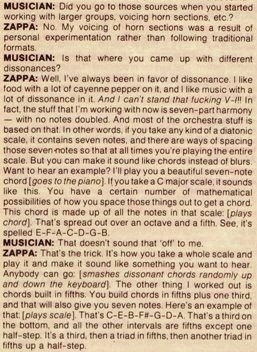 In an interview with Don Forte, Musician 19, 1979, Zappa talked about constructing larger chords of seven different notes (image to the right).
The two chords he demonstrated on the piano are (as minor seconds distances):
In an interview with Don Forte, Musician 19, 1979, Zappa talked about constructing larger chords of seven different notes (image to the right).
The two chords he demonstrated on the piano are (as minor seconds distances):
1) E-F-A-C-D-G-B: 1-4-3-2-5-4.
2) C-E-B-F#-G-D-A: 4-7-7-1-7-7.
It must have sounded like this:
The two chords from the Musician interview (midi file).
As he's explaining both are the full diatonic scale in different voicings. Upon the root note they would be the notes from E Phrygian
and C Lydian. 13th-chords in traditional terms, but the wide range of their voicing possibilities can make their sound pretty different, as
already these two chords are showing.
It is also known that from 1979 onwards, for his orchestral works, he was working with a chord collection he himself called the "chord bible".
Though the term chord bible isn't used during the interview with Don Forte, it does make it likely these two were part of it, especially since the
second can be heard being used during bar 1, beat 2, of "Mo 'n Herb's vacation, mvt. I" (see above). Information about this chord
bible is extremely sparse. David Ocker has mentioned its existence, saying that Zappa lost interest in it as soon as the synclavier arrived.
In an article by Jeff Spurrier called "Zappa on Jazz from Hell" (Music & Sound Output, March 1987), Zappa himself described it as:
"Every composer has notes, chords, and rhythms that he likes to hear. Some people keep it all in
their head and some people will jot down little sketches. Several years ago I made a classification
of all of my favorite chords plus the order in which I preferred to hear the pitches in the chord
arpeggiated. It’s all broken down from three-note, four-note, five-note, six-note, eight-note
chords. The chords are in different classifications, starting with those chords that have a minor
second as the uppermost interval, major second, minor third, blah blah blah, all the way down to
the fewest chords that have a minor ninth as the upper interval of the chord. There are real dense-voiced
chords and chords that cover four or five octaves."
And Steve Vai commented in an interview with Andy Aledort (Guitar Player, February 1999):
"I sat down next to him [at an airport]. "These are densities", he said, and showed me these huge,
odd chord structures, eight- and ten-note chords with no repeated notes .... If you start stacking
large groups of unrelated notes, you can get some horrible-sounding chords, or some lushly, exotic
chordal perversions".
These two citations are present in Brett's 2009 study, where he's making an attempt to estimate which chords might have been in it.
The first citation comes from Zappa's comment upon "The Beltway bandits", where he continues with saying: "There's a whole variety in the book.
The harmony in "Beltway bandits" is derived from Chord Bible harmony, and usually it's four- and five-note harmony. There are a couple of seven-note chords in there also".
There are a couple of factors that complicate matters:
- The chord bible itself is stacked away in the ZFT archive.
- It is not known what exact works it was used for. As it comes to orchestral music, Brett assumes these are the following works:
a) copyrighted in 1979: "Sad Jane", "Bob in Dacron" and "Mo 'n Herbs vacation".
b) copyrighted in 1981: "Envelopes" and "Sinister footwear".
c) copyrighted in 1982: "The perfect stranger" and "Dupree's paradise".
- It is not known to what extent Zappa was actually applying this chord bible to these works.
- These scores aren't available to the public.
- Actual performances on CDs can deviate from the printed score.
- Definition matters: Zappa's writing style is mixed (see below at "Pedro's dowry" for some comment). It can be homophonous, polyphonic,
hocketing and with rhythmic dissonance. So it's not always clear which notes are chordal and which melodic. Or maybe one should simply
look at any vertical combination of sounding notes.
Under these circumstances Brett's approach is reasonable, saying: "Because all of the aforementioned pieces contain hundreds of chords, it is
often possible to confirm safely a chord's status as a member of the Chord Bible (i.e., through its
repeated usage across different pieces). However, certain chords which appear only once—or
perhaps several times but in only one piece—will not be included in the catalogue of chords".
The results are presented in chapter V of his 2009 study, as well as his later article "An introduction to Frank Zappa's Chord Bible".
This article is largely overlapping with his 2009 study. New is his statement that "First, we
may outline a general history of the CB [chord bible].
To do so, it is necessary to divide the repertoire of
Example 1 into three periods—early, middle, and late—which correspond to copyright dates
1979, 1981, and 1982, respectively. Given the disparities in chord usage between early and late
periods, we can conclude that there was not a single CB in use throughout the entire time span."
In the Perfect stanger section I'm quoting some of his analysis of octatonic chords.
In the left menu of this site you can find links to a discussion between Brett and me taking place, with a relatively small part about this chord bible, pages 191-209 in Brett's
"Response to Kasper Sloots". In it I'm pointing at the relativity of some issues. It doesn't have to be repeated here. I'm willing
to accept the correctness of his examples and the possibility that these chords are indeed part of the chord bible.
There are two things that I feel less comfortable with, that I'd like to mention here:
- Above I'm calling a few chords Lydian, Aeolian and Phrygian, by taking the root note of a chord as tonic. Brett also does this, but not
systematically. In case of the chord E-F-A-C-D-G-B, he calls it a derivative of F-E-A-C-D-G-B. This latter chord upon F we both would call
Lydian. But in case of such large chords any chord can be seen as derived from another chord. What's a derivative of what is arbitrary.
- An overall problem remains the absence of sufficient data. Brett is giving examples of probable chord bible chords, but not
a list of in which (other) bars of which compositions he found them as well. This makes it hard to verify. Some other people have cited or tried to continue
Brett's work, but this problem remains. Eventually one would need the chord bible itself as well as a huge table with a classification
of all chords in these works (types and where they occur), and of course these scores themselves.
In case the chord bible never becomes public, or when trying to assess its impact, the best thing to do would eventually be the typing in of the complete scores
into a computer program and run a number of algoritms for indentifying the chords against it. Then publish all of it, the scores, the algoritms and the results.
In the Ulrich book you can find the following quote from a 1985 KUSC-FM radio interview by Charles Amirkhanian. This is another rare instance of Zappa himself explicitly linking a title
to the chord bible. The interview might still be present in their archives and a copy seems to circulate in the bootleg circuit (link below). So it looks correct.
This book is from 2018. Possibly Brett wasn't familiar with this interview, nor was I at the time we started our discussion.
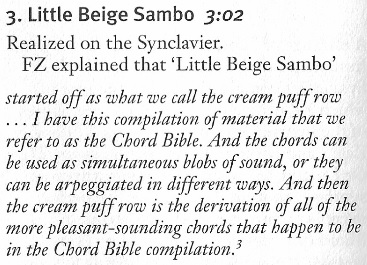
Content of the 1985 Zappa interview by Charles Amirkhanian.
This does answer one question. "Little beige sambo" is mostly diatonic. The opening
of this piece is included in the FZ meets the Mothers of prevention section of this study.
Of the works investigated by Brett only "Sad Jane" and sections from
"Sinister footwear" can be called diatonic (the theme from "Dupree's paradise" was written around 1973). Then why would Zappa have taken an effort to include
diatonic chords in his chord bible when it applied to only one or two works? But it raises a more disturbing question. If he applied his chord bible to synclavier works,
then which ones? And why not to his music for his band too, diatonic and atonal alike? Stylistically there are no fences between these categories.
One thing I can tell you for sure: if it's just about the most often occurring chords, then the major and minor triad should be on top, and the number of chord types
in all examples in this study is huge.
In his article Brett begins his conclusion with pointing at the fact Zappa seems to have used the chord bible during a relatively short time-span: "Surprisingly, given the great amount of effort
Zappa put into its compilation and employment, the CB system was utilized only for a brief
period in his career. His loss of interest in the CB appears to have coincided with his acquisition
of the Synclavier synthesizer/sample in 1983. According to his copyist David Ocker, the contents
of the CB were entered into the Synclavier, after which "this system [the CB] was soon
forgotten" [note 59, referring to an on-line interview with David Ocker]. How much CB harmony is present in the Synclavier music is unknown, but it is
clear that Zappa viewed the Synclavier as opening up wider compositional possibilities than the
CB. However, this fact should not lead us to relegate the works under study to a position of secondary interest in Zappa’s career."
2.1 Envelopes (1983)
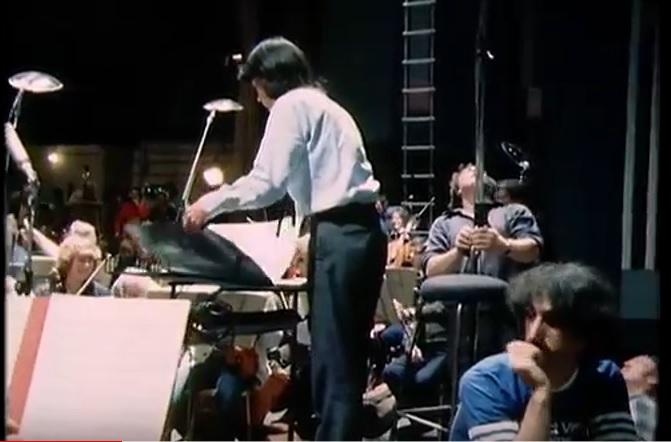
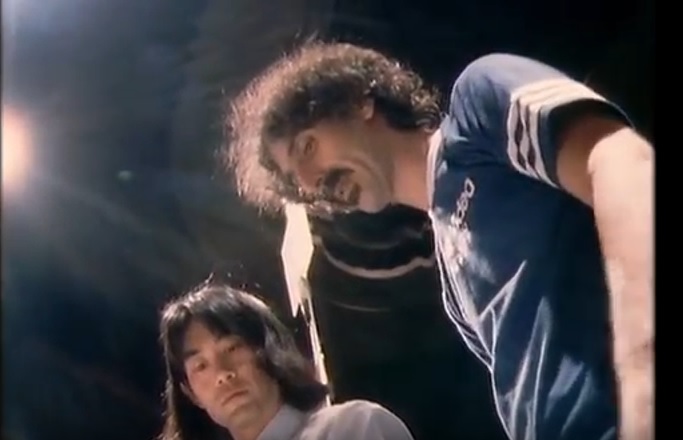
"Envelopes" was first released the year before in a rock band version. The differences between the orchestral and rock band version
are numerous. Just to mention some, the rock band version goes much faster: 2:25 against 4:04. Secondly this version knows
far more counterpoint lines, whereas the orchestral version is more dealing with harmonies. See
"Envelopes (1982)" from the Drowning witch section for more details.
In the section transcribed below, however,
the orchestra is also playing three-part counterpoint, as the rock band does from the beginning. It's all atonal here. Bars 9-11 offer a variation upon the material
in bars 1-3. Bars 15 and 16 follow the chromatic scale with parallel playing, leading to the repeated figure of bar 17.
Envelopes, 1:38-2:22 (midi file).
Envelopes, bars 54-55, score version (midi file).
Envelopes, 1:38-2:22 (transcription/score).
This example was transcribed from the CD in 2008 because of lack of an available score. It can happen, and very likely will happen more often,
that examples from the original score turn up elsewhere later on. In this case some samples
are shown in Brett Clement's article "An introduction to Frank Zappa's Chord Bible". I've included his example with bars 54-55,
corresponding with bars 15-16 from my example. The harmonies in the original score are much wider than what I can hear on CD.
This may be because not all harmony notes are brightly audible, but yet again there are real differences between the CD and the score.
In the score the tuba is playing a minor second above trumpet 1 in bar 54, on CD it is playing parallel with it. The tuba notes from
bar 55 are also going on CD as I've notated them. These are clearly audible, it can't be because I'm not hearing the skipped notes. As indicated
by Brett these two bars (score version) contain two chord types, that are played in almost perfect parallels. Only horn 3 starts playing the same notes as horn 2,
half-way bar 55. As minor seconds distances, they are:
- Bar 54: 2(+12)-1-2-2-2-1-3.
- Bar 55: 3(+12)-3-1-1-2-1-4.
And how that sounds is also included above, clustered dissonant chords with many second intervals in them.
Today's musicologists are inclined to look at printed scores only, trying to outdo each other with ever more complex diagrams
of relationships between the notes, far more detailed as what I'm doing in this study. It almost looks as if this has become a goal by itself:
the more complicated it looks, the more associations are made with other complicated theories, the better. By itself there's nothing wrong with that.
The thing that went wrong, in my opinion, is Brett's eagerness to prove a complicated theory of his own, his Lydian theory.
One of the outcomes of this study is that the written and printed scores are a collection of versions by themselves. About always they
differ from the versions that you can actually hear on CD. It shows the relativity of the highly sophisticated diagrams by musicologists.
The ease Zappa could deviate from it during rehearsals and recordings is stultifying.
Sometimes because a score is too demanding, but mostly
as an attitude, that he himself described as "anything, anytime, anywhere for no reason at all". In my opinion transcribing from CDs as accurately
as possible remains a necessity. These are just as valid collections of versions too.
The blunt reality is that musicologists are frequently analyzing something in detail, which the bulk of Zappa fans have never heard being played like that.
This is already happening in something relatively simple as "Dancing fool", and it certainly goes for the L.S.O. and The perfect stranger recordings.
Because of this, when encountering an original score, I'm often including both versions in this study.
In this context I would like to point at pages 177-182
of Brett's Response to me. Here he's assuming that during 1973-74 the band played some bars from "Dupree's paradise" following
the score. I'm showing both the handwritten score and a transcribed version from 1974. While Brett is suggesting George Duke may have had
problems with playing it accurately and that my transcription is incorrect, the reality is that these are version differences.
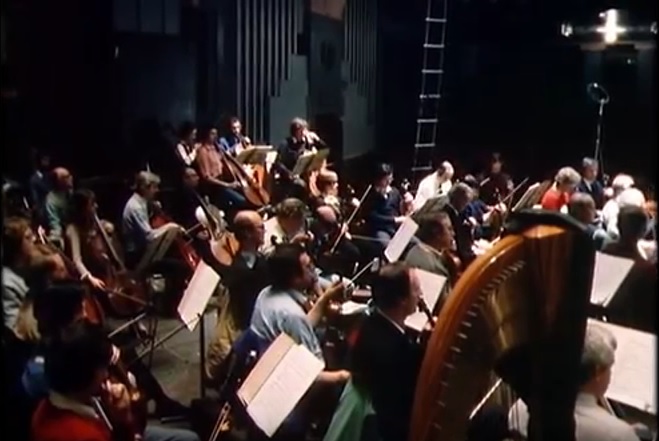
Next is the opening of "Envelopes". The difference with the "Drowning witch" version from 1982 (see the previous section) is radical and intentional.
Only the lead melody is kept the same, otherwise these are completely different writing styles. Other, less dramatic, differences are the insertion
of a pick-up bar and bars 5-6 with counterpoint figures. Brett's article contains bar 7-22 from the
orchestral score, of which I'm including bars 7-10 below.
Envelopes, 0:00-0:26, CD version (midi file).
Envelopes, bars 7-10, score version (midi file).
Envelopes, 0:00-0:26 (transcription).
Envelopes, bars 7-10 (score).
It's hard to exactly hear the notes from chords with over 6 notes in them. So the transcription remains a reasonable approximation with probably
a few errors and missing notes in it. The reason why I transcribed it nevertheless, is to notice that also here you can hear differences between
the CD and score version. I don't have a clue where these differences come from on this occasion. It's not difficult to play, it mostly doesn't make
things easier and it doesn't seriously affect its sound (as the midi files show). Differences that can be heard:
- 2nd chord from bar 7: next to the descant Eb (Eb4) there's also a lower Eb (Eb3). The lowest note I'm hearing is a G2. If there's a C2 beneath it, it's either
very faint, or absent altogether. There is a faint high G5 audible, however.
- Last grace note from bar 7: I'm neither hearing the melodic G2 nor anything from the chord, just an Eb as a normal 16th note.
On this particular spot, it can have been done to ease the performance.
- Grace note from bar 8: likewise.
- 1st chord from bar 9: I'm hearing an Ab2 as lowest note, thus below the C3 from the score.
- 2nd chord from bar 9: here I'm hearing a G2 as lowest note, thus above the Eb2 from the score.
- Of the two 32nd notes from bar 10 from the score, the first one got skipped on the CD, including the chord.
- Of the last three chords from bar 10, I'm only hearing three notes of each one clearly, all being staccato notes. Possibly
there's a note or two more to it, but not the 7-note combinations from the score.
- 1st chord from bar 11: if I'm hearing it correctly, the E is present as E3, next to, or instead of E4.
This means that the chords as minor seconds distances, densities as Zappa called them, are mostly different on the CD. The notes in them
are largely the same, but their voicing is often different. Both versions sound quite all right.
The origins of "Envelopes" go back to June 1970, with a studio recording appearing on the ZFT release "The Mothers 1970".
Next it appears in setlists from bootleg recordings from the 1977 fall tour. At one point it had
lyrics, as you can hear on the 2010 "Hammersmith Odeon" release by the ZFT. The composition since then developed into three directions simultaneously.
The ultimate rock band version from 1982,
the orchestral version and a version for wind quintet. The last one gets mentioned by Jonathan Bernard in his article
"Frank Zappa's crossover pieces". Above and below stills from the rehearsal sessions are shown.
2.2 Pedro's dowry
The tone for "Pedro's dowry" is set right at the beginning. Instead of developing a melody, it opens with a dissonant chord
followed by various individual notes and percussion. Quite bizarre to begin an orchestral piece this way. The whole piece is
extremely versatile, up to being aggressive, with all sorts of sections following upon each other overnight.
It can be calm chamber music at some moments,
in other bars half the orchestra is playing dissonants along an energetic drum part. The following section shows a larger
theme in 4/4 over a vamp, out of the blue followed by a chord in bar b).
At this point it's polyrhythmic. The drumset and
the brass part #2 continue in 4/4, while the woodblocks and the brass part #1 are playing in 12/8. The sustained notes can be notated in both ways.
In all probability Zappa took one
meter as leading to improve the readability, but I don't know which one (a couple of examples with the L.S.O. in this study are
transcribed; the original scores are available at Barfko Swill).
Pedro's dowry, 1:35-2:18 (midi file).
Pedro's dowry, 5:47-5:54 (midi file).
Pedro's dowry, idem, score version (midi file).
Pedro's dowry, 1:35-2:18 (transcription).
Pedro's dowry, 5:47-5:54 (transcription/score).
Pedro's dowry, sample bars/staves (score).
Three samples from the original score can be found in the Herraiz study, of which I'm reproducing some bars/staves in the second example. The examples from
this section and the 200 Motels, the Perfect stranger and the Yellow shark sections show that Zappa's writing style for orchestras and chamber music ensembles
is often a mixture of approaches:
- Monodically: a melody being played as a single line or in parallels, with maybe only some background accompanying notes.
- Harmonically: a lead melody with chords or all music forming a series of chords.
- Hocketing: (sections of) instruments alternate with each other for playing the melody or chords.
- Polyphonically: two or more parts follow their own melodic line.
There are no hard boundaries between the definitions of these approaches. Sometimes it's clear the one or the other. Sometimes it's more a mixture
and it's getting subjective where you would like to put the accent. This comes out in for instance the manner Martin Herraiz describes the sample bars from above:
- bars 91-92: "despite of the polyphonic texture, every block constitutes a clearly delimited sonority".
- bars 117-118: "closed hoqueting, creating a feeling of polyphony".
- bar 151: "example of polyphony without rhythmical dissonance, the parts not being completely independent".
So it's mixed, that's for certain. When comparing bars 117-118 with the CD, the result is comparable to what happened in 1971 with the "200 Motels"
recordings: the limited rehearsal time necessitated an adaptation of the score. While
the score knows chords for most sections of the orchestra at this point, in most cases only
single notes from these chords were chosen to be actually played. The detailed dynamics aren't followed
that precise. In the third midi file from above I've included all notes, but
no dynamics. So you can understand why Zappa called the recording a good demo,
rather than a full performance of what's in the score.
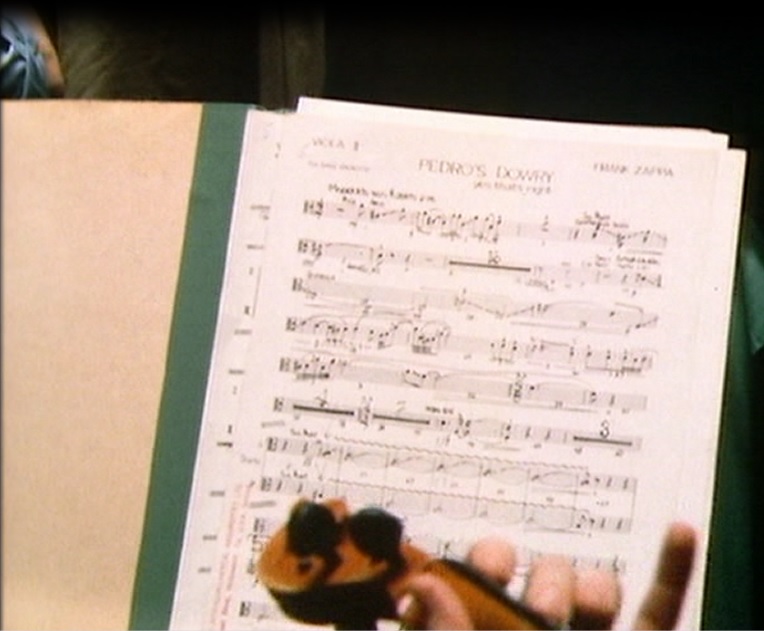
Opening page of the viola II part. Screenshot from the L.S.O. rehearsing "Pedro's dowry" (Eat that question DVD).
"Pedro's dowry" goes back to at least 1975 when it got recorded for "Orchestral favorites". See the corresponding section for the existence
of a choreography for this piece.
2.3 Bogus pomp (1983)
One of the examined pieces in the Allen Wright study (see above) is "Bogus pomp" (L.S.O. version), where he looks at the orchestration. In his opinion "Bogus pomp"
is made up of smaller blocks of around two minutes with various types of orchestration. He notes that it is
"the recurring deployment of a given orchestration [that] provides a sense of overall continuity to the piece".
My study hardly deals with this subject so it offers a quite different angle to look at Zappa's music. He also notes that "Bogus pomp"
is highly sectional, having a lack of thematic form. It is true that this piece was composed in blocks, as indicated in
the tracklist from "200 Motels" and the scores then used. The "Overture" and
"Centerville" sections, that were added to the 1983 version, are unrelated separate blocks. They now serve as some sort of prelude
to the 1975 version, but could just as well have been indicated as separate movements. I agree
with Allan's conclusions, though I feel uncomfortable with the assertiveness of his choice of words. I'd rather say that
the unity in "Bogus pomp" comes from various elements equally important as motivic relationships (in
the Orchestral favorites sections I've presented some of them), stylistic continuity (Zappa talked about "cheesy
fanfare music") and the orchestration.
David Ocker was also asked to re-orchestrate
"Bogus pomp". Zappa could neither apply the "200 Motels" nor the "Orchestral favorites" scores one on one to the L.S.O.
Sections from "Bogus pomp" aren't in present in "200 Motels" and the "Orchestral favorites" orchestra was much
smaller than the L.S.O. orchestra. So the "Bogus pomp" (1975)
piano variation, as presented in the Orchestral favorites section, now gets spread out over the string sections from the L.S.O.
The notes are identical, the sound is much different.
Bogus pomp (1983), section (midi file).
Bogus pomp (1983), section (transcription).
The material from "Bogus pomp" was built up in a couple of phases:
- Zappa started composing themes from "Bogus pomp" around 1968 and several pieces were performed by members of the BBC Symphony Orchestra in that year.
In this study a section from "The rejected Mexican pope leaves the stage" is an example from this 1968 execution. That particular section
is a variation upon one of the themes from "Bogus pomp", that later on would get skipped.
- In 1970 Zubin Mehta conducted the L.A. Philharmonic, playing some of the scores Zappa had prepared for his upcoming "200 Motels project", including
parts from the later "Bogus pomp".
The opening bars from "Dance of the just plain folks" are present in
the Fillmore East 1970 section.
- The scores for "200 Motels" and "200 Motels - the suites" contain most of "Bogus pomp". See the 200 Motels section for the
"Overture" and "Centerville", that in 1983 came
to serve as the opening block of "Bogus pomp". The larger part of "Bogus pomp" corresponds with
"This town is a sealed tuna sandwich"
from 200 Motels, of which a few sample bars are included in that section too. The 1983 version of "Bogus pomp" does have a newly composed coda of its own.
- See the Orchestral favorites section for variations upon the "This town is a sealed tuna sandwich" theme, the theme that returns the most
during "Bogus pomp". The piano variation already got mentioned above.
2.4 Strictly genteel (1983)
"Strictly genteel" returns a couple of times in Zappa's output in different settings:
- "200 Motels, the suites": original version including lyrics.
- "200 Motels" (CD): idem, plus an ending with a rock piece, followed by some deliberately chaotic music.
- "Orchestral favorites": instrumental version for smaller orchestra.
- "L.S.O.": instrumental version for large orchestra.
- "Make a jazz noise here" and "YCDTOSA vol. VI": instrumental version for rock band.
This piece can be used as an example for many aspects of Zappa's music, for instance its instrumentation, its waltz meter or being diatonic orchestral music.
This title is also getting attention in three academic articles/studies, the ones by J. Bernard, A. Ashby and B. Clement (see the references for the details).
Here I'm looking at it for its form, using the L.S.O. version for the transcriptions. It's a variation piece with a central theme and a number of
side themes. First its opening with the main theme:
Strictly genteel, opening-main theme (midi file).
Strictly genteel, opening-main theme (transcription).
Bars 1-4 serve as the introduction for the main theme, letting the piece begin in D with the progression D-A-Em-D-E. Bernard calls the piece "nominally
D major, but given a somewhat peculiar coloring by the repeated emphasis upon an E-major triad of ambiguous function. i.e. not V of V" (Listening to Zappa, page 88).
During these opening bars you can see that G natural and G sharp are used next to each other, next to a one time only A sharp. Within the context
of Zappa's music this can also be seen as a blending of D major and D Lydian. Using closely related scales next to each other is common in Zappa's music.
B. Clement can correctly call bars 4-7 D Lydian and identify the remainder as "functional D major harmony" (page 162 of his study). As indicated by Bernard, the
chord progression of the main theme is D-A-E-F#-D-G-A. As I'm hearing it the second D chord should be a Bm chord, as also noted by Clement,
the total progression thus being D-A-E-F#-Bm-G-A. Another thing you can notice, is that it is mostly a parallel movement of major triads. Such parallel movements
occur more often in Zappa's music and can cause an ambiguity towards which scale they are in by themselves. See also my discussion of "The idiot bastard son". So there is no unique way of looking at "Strictly genteel".
Block I: Exposition of the main theme.
- 0:00 Intro.
- 0:09 Main theme.
- 0:34 Main theme with minor melodic changes plus some extra bars.
- 0:51 Main theme with some more melodic changes, the chord progression still being kept.
- 1:16 Side theme #1.
- 1:23 Side theme #2.
- 1:33 Side theme #3.
Block II: Character variations upon the main theme.
- 1:49 The main theme returns in a different set-up (form A). The melody changes again, while some of the chords get skipped. Here it has
become a variation made up of two phrases, both using the chord progression D-A-G-A. The final A chord gets extended to A11.
By character variations I mean variations that aren't varying the whole theme, but taking over some of its characteristics.
- 2:14 The main theme returns in yet another set-up (form B), this time with the progression D-C#m-F#-G-A. Compared to the initial form, some chords
are skipped again and the E chord is replaced by a C#m chord. Zappa keeps changing the melody to the point that only the global outlines
of the original are still recognizable: the rhythm and the downwards-upwards directions.
Block III: Re-exposition of the main theme.
- 2:35 Re-exposition of the main theme with the progression D-A-Bm-F#-Bm-G-A, more similar to block I.
- 2:55 Main theme with a different tail.
Block IV: The character variations upon the main theme return.
- 3:13 Re-appearance in form A. With every variation Zappa keeps changing the instrumentation. Tempos can also change.
At this point the orchestra is playing in full. With the orchestra score unavailable to the general public, reproduced examples come in handy. Bars
94-99 can be found in the article by A. Ashby. These bars correspond with 3:13-3:24 on the CD. Now you can see every detail of the orchestration, as well as that the chords
are bigger than just triads, at least at this point. The D is Dadd2 or D9 (without #7), etc. Ashby comments as follows: "In all contexts and groups,
electric or acoustic, an obvious "orchestralness" comes across; the work is an orchestral showpiece, a kind of Zappaesque Bolero, where the strophic
repetitions display sections of the orchestra in turn (harp, percussion, woodwinds, trumpets etc.)" (anti-fetishist orchestra article, pages 593-595).
Strictly genteel, character variation (midi file).
Strictly genteel, character variation (notes).
- 3:33 Re-appearance in form B. This is the fragment that has been in this study from the second edition onwards as an example of counterpoint,
where two melodies are played by the bass and descant. The bass line was at first played lightly in the background, but is now
coming out clearly to the fore. At several points the harmonies become complementary, while at other instances they are
moving more separately. As in all of "Strictly genteel", both melodies are in a straight 3/4 time.
(The tonal ambiguity has already been spoken of above. In the previous editions, with only this example, I wrote: Since there are no clear keynotes
here (in major the melodies are using notes of D, A and B), the chords can better be
identified unrelated to keys. In the first bar for instance, the bass and descant are playing through the D chord. In the second bar
they are playing mostly through the C#m chord. The progression in total goes as D-C#m-F#-G-A.)
Strictly genteel, counterpoint variation (midi file).
Strictly genteel, counterpoint variation (transcription).
Block V: Interlude
- 4:00 A D-E chord alternation passing through a wide range of different positions (see below at this paragraph). Throughout the piece D major and D Lydian keep returning as
the main scales. While the previous character variation (form A) is in D major, this interlude is in D Lydian. The relationship with the main theme is still remotely
present in the sense that these two chords are occurring at the start of the main theme.
- 5:13 Coda for this block, playing around Bb-C#-G-Aadd2.
Block VI: Finale
- 5:37 Another character variation, itself being a variant upon form B. This is a melodic-harmonic variation, with the chords as shown in
the following example:
bars 1-2: final Aadd2 chord from the preceding.
bar 3: D.
bar 4: A.
bar 5: Bm-A-Em7. So far this variation is in D major.
bar 6: G-C-A. From bar 6 onwards, notes are getting altered, making the music glide through different scales
in a rather indefinite form. The implied scale of bar 6 is D Mixolydian.
bar 7: Gmaj7-Eb add2-E (in the example the Eb is notated as D#).
bar 8: F#m-5-C+5-F7.
bar 9: Dm7-E7-Dm7. The A# by the bass during the third beat can be seen as a chromatic passing-through note. The writing style is getting mixed. All parts combined form the mentioned chords, but their
individual movements are going into different directions. Staff 2, staves 3-4 and staff 5 follow contrary paths.
bars 10-11: G add2-G+5-Dm7. With this last Dm7 chord, the example below stops and we're getting at the final theme.
Strictly genteel, harmonic variation (midi file).
Strictly genteel, harmonic variation (transcription).
- 5:53: Final theme.
- 6:27: Closing chords, D-A-E, fading out.
- 6:56: End on the L.S.O. CD. The version differences of the above mentioned "Strictly genteel" recordings are described by Bernard in his other "crossover" pieces
article, pages 166-167: the final bars 181-4 were skipped in the L.S.O. version, but present in the 1988 rock band edition. On "Make a jazz noise here" they are
played during 6:01-6:13.
"Strictly genteel" can be called classical in a number of aspects. It's a classical example of applying the art of variation, it's classical in its way
of orchestration and it's classical for its quality, though the last is not just for me to decide. Bernard writes that "As the piece progresses, this material
[1st example from above] is subjected to minimal variation, with occasional chromatic digressions that somehow never manage to eclipse the overriding
sameness; the oom-pah-pah of the main theme closes the piece" (Listening to Zappa, page 88). I can (only) follow this as it comes to the rhythm. As I've been pointing at in the Roxy
section, Zappa follows any method as it comes to rhythmic diversity and this can also mean emphasizing standards. Here it's plain 3/4 with never any form
of complexity within this meter. Ashby starts his article with quoting Zappa about, among others, Beethoven's fifth: "How many times do you want to hear
Beethoven's fifth? [...] it's all tweedlydeedlydee" (anti-fetishist orchestra article, page 557). See also my FZ quotes section from the left menu for some nuances.
This shows that it's virtually impossible to form theories about Zappa, and Zappa's own remarks often only contribute to the confusion. In "Strictly genteel" it's
Zappa himself doing "tweedlydeedlydee" or "oom-pah-pah", and this is not exceptional nor should it be explained away as parody music.
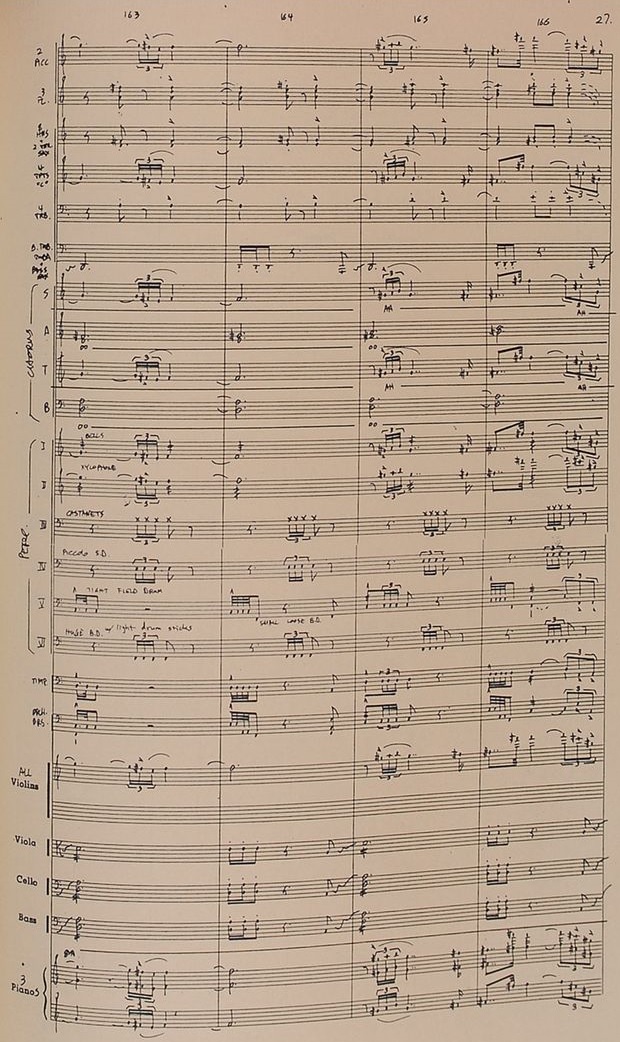
Sample page from "Strictly genteel" in Zappa's 1971 handwriting (the meter is 3/4). The CD booklet of "200 Motels" contains another sample in a thumbnail format.
Strictly genteel, opening of the interlude (midi file).
These are the opening bars of the interlude, 1971 version including the chorus. Over a D pedal you can hear the D-E-D-E progression going upwards. Because of the sustained
notes, these two chords get to a degree mingled.
On the L.S.O. CD these bars correspond with 4:00 through 4:14 with this episode being played twice.
For further reading about "Strictly genteel" in this study:
- 200 Motels section with the opening page of the 1971 score.
- Orchestral favorites section with the "Every poor soul who's adrift in the storm" episode from this piece.
 The performances of Zappa's orchestral works were haunted by low budgets, limited rehearsal
times and union regulations. The first recording stems from 1961 with the Pamona Symphony Orchestra performing music for the "World's greatest sinner" movie.
It had a very poor budget and the whole orchestra went on a single track. Zappa called the result rancid (regarding sound quality I presume). Otherwise
it's pretty interesting material with some
examples being included in this study.
The recordings for "Lumpy gravy" and "200 Motels" also suffered from low budgets.
At the end of the seventies talks were held with the Vienna Symphony Orchestra and the Residence Orchestra of The Hague for doing sponsored concerts.
In both cases Zappa got confronted with unannounced extra costs along the way. The projects were annulled, but Zappa had by now all his scores
copied at his own expense.
The performances of Zappa's orchestral works were haunted by low budgets, limited rehearsal
times and union regulations. The first recording stems from 1961 with the Pamona Symphony Orchestra performing music for the "World's greatest sinner" movie.
It had a very poor budget and the whole orchestra went on a single track. Zappa called the result rancid (regarding sound quality I presume). Otherwise
it's pretty interesting material with some
examples being included in this study.
The recordings for "Lumpy gravy" and "200 Motels" also suffered from low budgets.
At the end of the seventies talks were held with the Vienna Symphony Orchestra and the Residence Orchestra of The Hague for doing sponsored concerts.
In both cases Zappa got confronted with unannounced extra costs along the way. The projects were annulled, but Zappa had by now all his scores
copied at his own expense.
After the ill-fated 1982 European tour, he decided not to wait for another chance, but
aimed at getting his scores performed one way or the other by hiring an orchestra himself. The L.S.O. was a self-governed orchestra
that volunteered to take this opportunity. In Kent Nagano Zappa had found an enthusiastic conductor
(photo to the left by KassKara). The way Zappa describes the event in The real Frank Zappa book is good
reading stuff but tendentious. The aim was to get as much recordings as accurate as possible in the about eight days that were
available. That was an inner conflict of course. It came to a head during the last hour that was reserved for the final
take for "Strictly Genteel". The trumpet section came in 15 minutes late after a break in the pub and Zappa, who was paying for every minute, hated
it seeing the chance for a better performance lost. It's a pity that this has become to overshadow that in general everything went well:
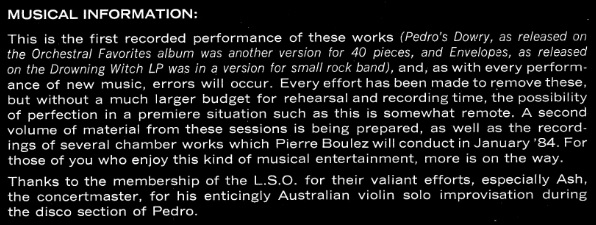
Part of the original 1983 album back cover, also included in the CD booklet, with Zappa thanking the membership of the L.S.O.
I personally consider Vol. I a masterpiece. Zappa had impeccable ears and apologizes for the mistakes in the recordings, but the average listener probably
won't notice (including myself).
His sense for accuracy also inhibited some further performances to appear on record as the concert including "Sinister Footwear" by the
Berkeley Symphony Orchestra in 1984. When rehearsal times were too short, he wouldn't even allow a performance at all.
